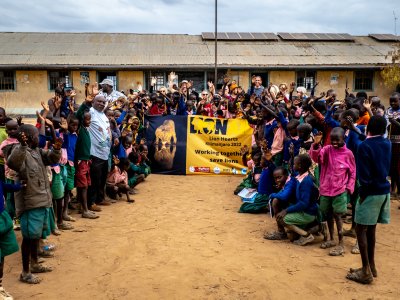News
Latest Lion Aid News
Tag: schools
HOW DIFFERENT CHILDREN SEE LIONS - AND WHY IT IS IMPORTANT.
Thursday 25th August 2022
|
During our recent visit to the Naorr Enkare primary school in the Merrueshi Maasai community on the border of Amboseli National Park in Kenya, it was notable the difference of children’s perception of lions in Kenya versus the UK.
Of course there would be. Children living in impoverished Kenya rural communities whose livelihoods are threatened by predators taking their livestock is going to be different from children living in the UK. For UK kids, Simba, Mufasa, Nala, Pumba, Timon and Rafiki (“The Lion King” characters) are regularly mentioned when LionAid conducts classroom visits to talk about the need to conserve lions in the wild. Have a look at the difference in these drawings made by children of equal age in UK versus the Merrueshi area… Lion drawing by a UK child  Lion drawing by a Maasai child  Also, read these excepts from letters sent by Maasai children at the Naorr Enkare school to UK primary school children speak volumes: 1. – I want to be a moran [Maasai warrior]. I then I kill those animals who was eat our livestocks. Lion is the best animal dangerous. Because they will want to kill our livestocks.
2. Do you have a lion at your village? My favourite colour is green. My pet is lion.
3. In our country they are many animals in our country and their very dangerous.
4. Do you have the game park? Or game reserve?
5. My name is James I am a Maasai and the lions were very dangerous in our county come and kill our livestock.
6. We have many animals we can see. Also we have lion giraffe and zebra that animals were dangerous.
The Merrueshi Maasai community borders straight onto Amboseli National Park – one of the “jewels in the crown” of Kenya’s protected area network. It is estimated that Amboseli earns the Kenya government between $1 million and $3 million annually in tourism income. Little of that income, if any, flows to the communities owning crucial land to maintain those wildlife populations outside the National Park. The communities are expected to share their land with wildlife – and such wildlife competes with community livestock for grazing and causes livestock depredation via predators. The Kenya government passed laws to compensate communities for damage caused by wildlife, but such compensation is rarely paid.
According to a community Elder – “The government have a policy to compensate communities either there (sic) animals or when death arises because of attacks by wildlife. It is not known when was the last time the community get (sic) compensated though they always feel [fill] forms provided". In other words, Kenya’s national parks that depend on lands belonging to neighbouring communities to maintain wildlife populations that tourists come to see --- are not fairly compensating those communities. Also, the Naorr Enkare school has a large capacity water tank built close by during Kenya’s colonial times and a big (modern) diesel pump. The water is supposed to be provided via a pipeline from fresh water springs in Amboseli to benefit communities but the tank has stood empty for some time. No wonder Maasai children are at least ambivalent to wildlife? Unless there is a concerted effort to benefit local communities and their children to conserve wildlife - and involve communities in benefits accumulating from wildlife, Kenya’s wildlife will not thrive.
Tags: lions, Kenya, Maasai, schools, schoolchildren |
Add a comment | Posted by Chris Macsween at 16:26




